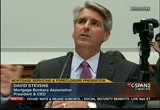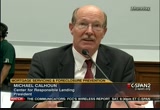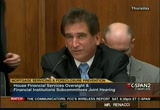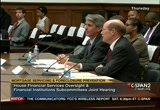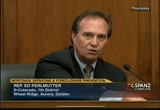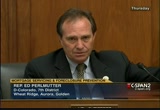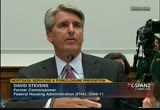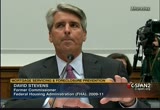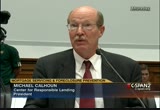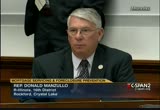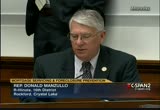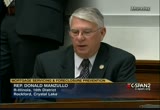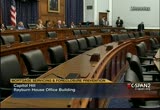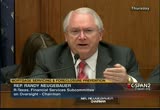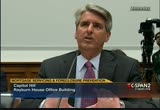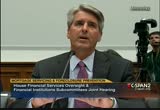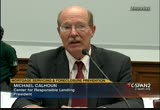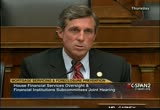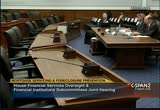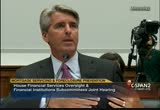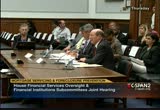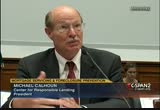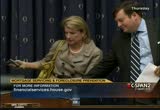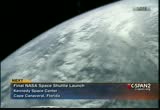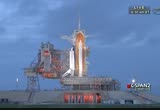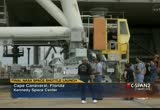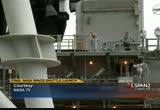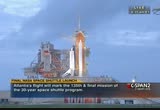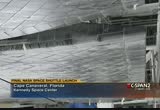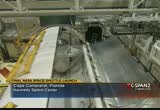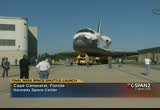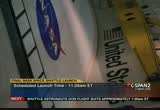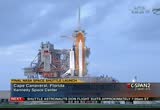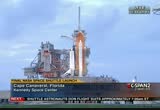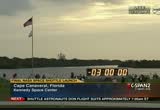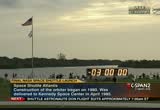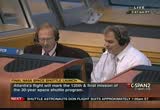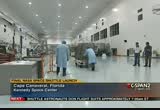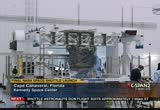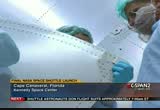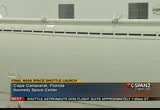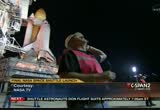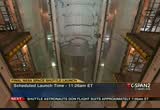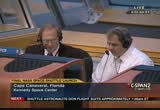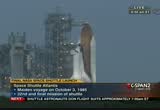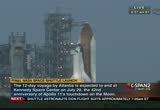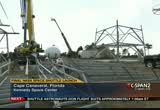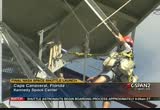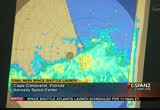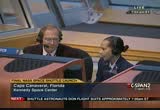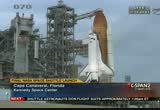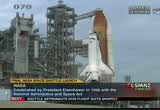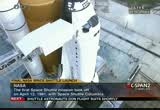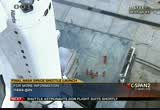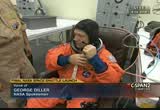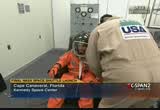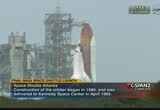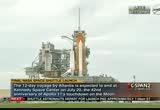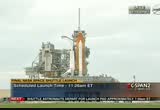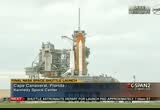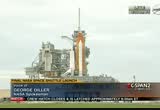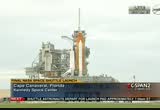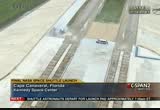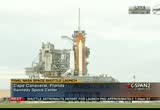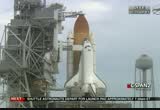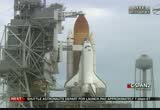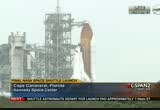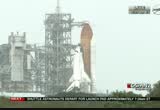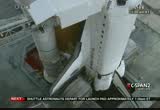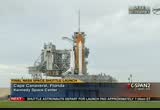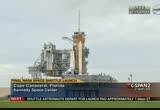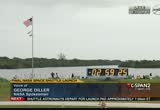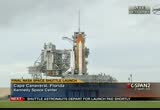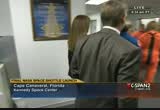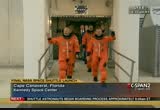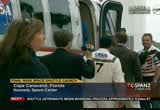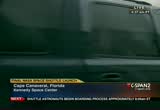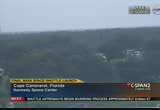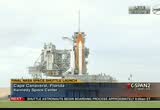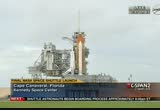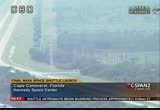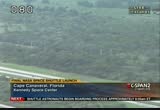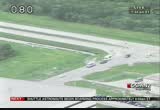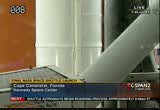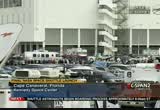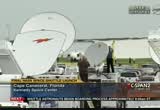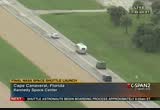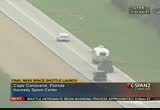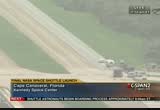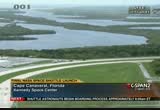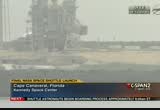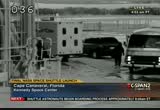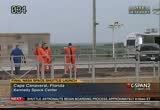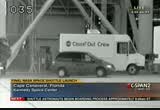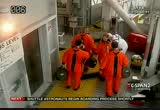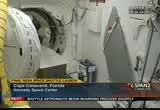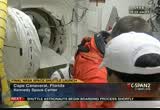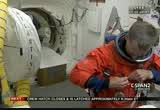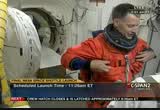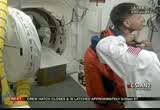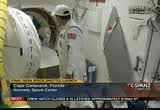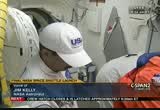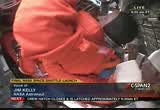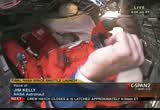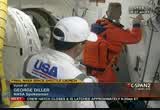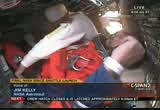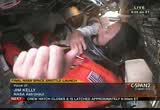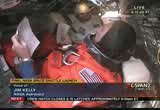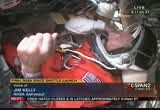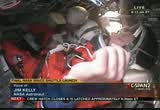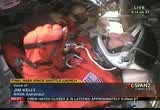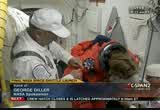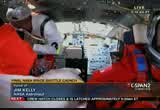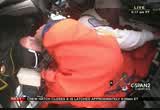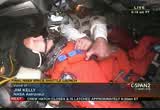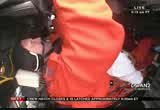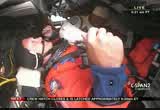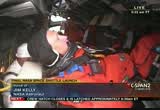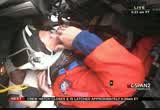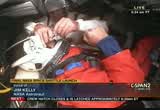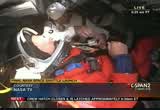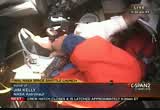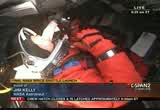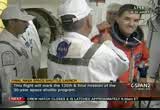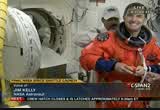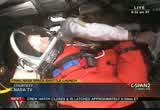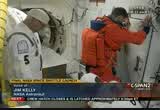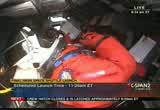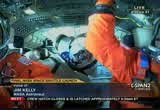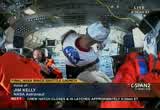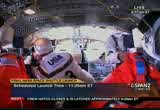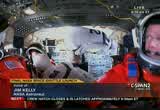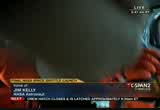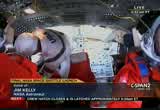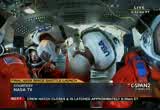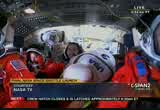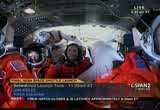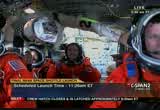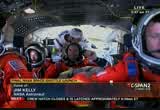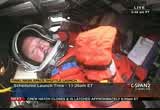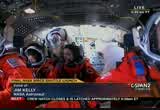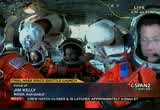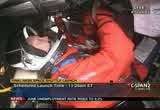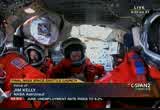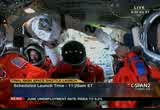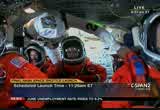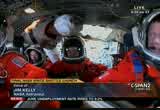tv Today in Washington CSPAN July 8, 2011 6:00am-9:00am EDT
6:59 am
7:00 am
as opposed to the older one which was only 60 feet. it puts it at about 130 feet. you can see them lifting it with the crane. some of the advantages that this writer has over the old one is that this newer radar is a dual polarization. this allows the radar to view participation particles both horizontally and vertically as opposed to just horizontally with the old radar. this can help identify the type, size and number of participation particles which greatly improve our warning accuracy. and you can see also the new site, it's about 23 miles to the west of many of the launch pads on kennedy space center. the reason it is here as opposed to the air force base worthy of
7:01 am
older one was located was because one reason was the height. this one here it would have intruded into the airfields safety corridor. and another reason that it is here at the current site is because it has an unobstructed view to cape canaveral and kennedy space center. the older raider have to transcend across many large buildings and cocoa beach. and there you can see. so there's a clear line of sight from the radar to kennedy space center which greatly helps us a lot. here we have our radar launch whether operator and he is actually manning the radar as we speak.
7:02 am
there you can see some shower, thunderstorm activity moving over the cape and kennedy space center. well, right now the crew is getting a weather briefing. and i wonder if you go into that for us. tell us what the forecast is today, what the download is, what are we seeing coming up over the next few hours, particularly when we get to lunchtime? >> there's a tropical wave in the eastern caribbean which has been slowly pushing towards the north. for today we are looking for almost the same other conditions as yesterday. many grain showers and isolated thunderstorms. we still have a 30% chance of fair weather for the launch. however, as the day progresses our chance to get better because
7:03 am
the system pushes towards the north which makes it much more drive than it is currently. our weather conditions at all three tower sites are good ago. also be a abort site is also good. so many weird concerned with the weather here at kennedy space center. >> what probability is cathy winters currently putting on our forecast? >> currently the probability 70% no go, 30% favorable. >> all right. well, as we go into tomorrow, what do saturday look like and what the sunday look like? >> on saturday our chances are 40% favorable. and on sunday its 50% favorable. so still almost the same weather conditions. >> all right. at least the trend is in the right direction. we live and help. >> yes, we do. >> well, thank you very much, master sergeant howard, for
7:04 am
telling us about the new radar and bringing us up to date on the forecast. i know the crew is just finishing up their weather briefing and getting ready to go to suit up. up. so thank you very much. >> thank you very much for having me. >> we are at t-minus three hours. this is shuttle launch control. [no audio] [no sound] [no sound]
7:08 am
7:09 am
doug hurley. this is his second trip into space. he completed his first spaceflight -- he has logged more than 736 hours in space. and here is mission specialist number one, sandy magnus. this is her third spaceflight. she has spent more than four months in space aboard the international space station. she flew on sts 112 and in four and a half months after being on board the space station as a member of the 18 crew.
7:10 am
this is rex walheim, our mission specialist number two. he is making his third spaceflight. is spent more than 24 days in space on sts 110 and sts-132 wanted to end his had five spacewalks total more than 36 hours. and he is her very effectively as -- he has served very effectively. so the crew now is finishing pursuit of activities, and they are scheduled to leave for the launch pad and just about 25 minutes. shuttle countdown is continuing to go very well. there's nothing amiss there at all. and the weather is the only concern. maintaining will be, continue to
7:11 am
be the low cloudiness, particularly at the shuttle landing facility should we have a need for the crew to turn around and come back with the shuttle, return to launch site. and 80% precipitation. and we have not exactly 20 minutes remaining in this hold at t-minus three hours. this is shuttle launch control. [no sound] [no sound]
7:15 am
>> this is shuttle launch control, t-minus three hours and holding. we have just had a weather update that was just passed your shuttle weather officer. on the sea conditions offshore for the solid rocket booster recovery after launch today. and the ships are reporting that the seas are four to six feet. the sea temperature is 83 degrees in the water. air temperature is 80 degrees. the winds are from the south at 20 knots, occasionally 24. excellent visibility, at least 10 miles. and it is overcast though, just as it is here. and mike leinbach, our launch director, has just asked for another update on the weather.
7:16 am
the astronaut's touchdown arriving from houston on monday, the fourth of july at 2:31 p.m. since that time commander chris ferguson and pilot doug hurley have been honing their landing skills in the training aircraft. a final inspection space shuttle atlantis, had a fit check with their launch in increases, a debriefing on the steps of space shuttle atlantis, and also the payload. they have been following the weather forecast very closely since they have been here, knowing that marginal weather was moving in. and then have their final medical exams and did a final review of their flight plan, and then packed their flight data files and personal effects and they were sent out to the pad to
7:17 am
be placed aboard the middeck of atlantis. today, the crew was awakened at 4:30 a.m., had a brief checkup by the flight surgeon before having breakfast at 5:45. and as we've heard, they've had their weather briefing. the walkout from the astronaut is scheduled for 7:36 a.m., in about 20 minutes from now. and they are scheduled to begin boarding atlantis at eight '06, and then the access hatch will be closed and sealed at 9:21 am.
7:18 am
>> the ice inspection team, the final inspection team has completed walking down the entire length of the structure and they are just about down, go down to the pad surface. they will do some final inspections around the mobile launcher platform area, the aft skirts, some activity to do there and then they will leave the pad. and they will come back your to launch control center and report to our shuttle launch director, mike leinbach, and engineering community about what they found during the walk down. close out crew is in the white room now, and they are ready for the astronauts to arrive.
7:19 am
>> members of the close out room are in white coveralls, and they will be assisting the astronauts with their helmets and other equipment as they enter the orbiter. >> white room is at the 195-foot level. the white room is on the end of the orbiter access arm. there are six people altogether who make up the close out crew, these include a pad leader, a support astronaut, a suit technician, a quality control engineer, and to orbiter mechanical technicians.
7:20 am
7:21 am
right now. there are no significant issues in work for the engineering team to discuss, so they will be waiting to hear what the final inspection team has to report. so, other than weather, we continue to have a very smooth countdown going. and with only 10 minutes now remaining in this hold at t-minus three hours. this is shuttle launch control. [no sound] [no sound]
7:24 am
[no sound] [no sound] [no sound] >> this is shuttle launch control, t-minus three hours and holding. six minutes 45 seconds remaining in this built-in hold. the final inspection team is now back at the launch control center. shuttle weather officer kathy winters is briefing once again, but from the briefing room we
7:25 am
heard being given to the flight crew it doesn't sound like very much has changed. we're going to have astronaut rick mr. cole a little bit later on flying weather reconnaissance, a little before 9:00 you scheduled to take off in a to t. 38 jet to fly afford our to do some of the initial weather reconnaissance, based on what we've seen from radar and satellite he has already been given some direction on where they would like him to go out and reconnoiter. and then a little after 10 a.m. he will take off in the shuttle training aircraft to further assess the current weather, as well as the weather's direct effect on the handling characteristics of the orbiter, anything of return to launch site. he will be shooting approaches to the runway and shuttle landing facility, and judging the visibility and the when conditions and its effect that it would have on the shuttle. you will be passing his
7:26 am
observations to john casper, the weather court near here in my room for. and the mission control in houston. the forecasters at the spaceflight meteorology group in houston, part of the national weather service are going to be listening very closely to what he has to say and providing any updates to those forecasts either for here at kennedy for return to launch site if that's necessary, and for the overseas landing sites in spain and france. right now those sites all look good. all of the standard weather observations and forecasting normally perform before launch are being done today. the final phase began yesterday with a series of balloon releases. in the last 24 hours, about two dozen weather balloons of all different types were released.
7:27 am
and today we have nine instrumented balloons to collect data on temperature, humidity, wind speed and barometric up to about 100,000 feet. six are being released that provide very highly accurate data on the wind speed direction, up to about 60,000 feet. this data is reduced and the countdown officers will select the proper computer program to allow the onboard computers to respond properly to the when conditions that they have observed, as the shuttle atlantis climbs through the lower atmosphere. >> three and a half minutes remaining in the built-in hold. this is shuttle launch control.
7:31 am
[no sound] >> this is shuttle launch control. coming out in five, four, three, two, one, t-minus three minutes and counting. -- three hours and counting. and right now the primary asset guidance data is being transferred into the backup flight systems on board atlantis. these are the flight profiles. this is part of the program we
7:32 am
7:33 am
>> as we saw in a suit of rooms are for astronauts astronauts on this last flight who will shortly be in route to the launch pad. they will be rendezvous in with atlantis, with the international space station on sunday. atlantis will be delivering the raffaello multipurpose logistics module, which is filled with supplies and spare parts to sustain space station operations when the space shuttle is retired after the current mission. there is one planned eda or spacewalk on sts-133 five outside the international space station, to do as joe delight told us, to remove and replace a failed ammonia palm module and to install onto the space station a technology development
7:34 am
7:35 am
7:37 am
7:38 am
7:39 am
7:40 am
nasa test director now is pulling the primary systems here in the firing room to assure that there is nothing amiss before we send the astronaut van out of the astronauts begin boarding. it's a costly thing to make sure we have no launch commit violations before we put the crew on board. and there are not.
7:41 am
7:43 am
[no sound] >> this is shuttle launch control, spatial launch director mike leinbach has just completed having a discussion with houston flight. the spaceflight meteorology group, a 45th weather squadron, and some members of the mission management team. with the weather uncertainty want to make sure we have a consensus, the right thing to do is continue with the countdown and with the crew on board, and
7:44 am
what he told the launch team that we do have a shot at this today. so while it's not ideal, there is a chance for a launch, and the direction is to press on. so, we will be following the crew. they are letting off rick sturckow so he can go out to shuttle landing facility and be in flight in t. 38 to do some weather reconnaissance. he will later be on the shuttle training aircraft. and then they will probably stop in front of a launch control center, drop off some senior management and then head on out to the pad. at t-minus two hours or six minutes 34 seconds and counting, this is shuttle launch control.
7:52 am
7:53 am
7:55 am
[no sound] >> the crew is doing what many of the crews like to do before they go up and board. they like five minutes or so to go up on the pad and take a look at atlantis, pose for some pictures in front of their shuttle before they board. and then headed over for the elevator. the pad surface, they will be going up to the 195-foot level of the structure.
7:56 am
7:57 am
7:58 am
8:00 am
[no sound] >> this is shuttle launch control, t-minus two hours 31 minutes five seconds and counting. the flight crew is now in the white room of the order access arm. members of the close of crew are in the white coveralls, and the astronauts of course are in the orange suits. the close-up crew will be assisting the astronauts with their helmets and other equipment as they enter the orbiter. and the close-up crew is scheduled to seal the orbiter access hatch at 6:56 a.m., but this can be done up to an hour later if that's really necessary. right now chris ferguson is
8:01 am
being assisted with his launch and increased. he is her sts-135 commission -- mission commander. he is making his third shuttle flight. he has logged more than 28 days in space, and he served as the spacecraft communicator on another space shuttle mission. he was the pilot on sts-115. so during those commissions he has lost more than 28 days in space and he has also prudently held the position of deputy chief officer. joining us right now here in the firing room is jim kelly, astronaut jim kelly. ..
8:02 am
he is currently chief of the a cc capcom in houston. it is very good to have you here today and to be able to talk us through the activities as the crew gets on board. tell us a little bit what the crew has been doing besides the obvious things they customarily do when they get up in the morning. what has their activity been like this morning so far? >> they have been getting ready
8:03 am
for the mission. they have been up for quite awhile before they get to this debt and of little bit of a leisurely morning to relax. they get their final briefings on the weather and any changes in flight plans and sit down and talk about and eat something before they fly into space and get ready to go. all dressed up now and christopher ferguson is just getting ready to get on board. >> there at the end of the day. once they reach orbit what are the things they will be doing since this is at the end of the crude they? >> it is based on when they rendezvous with the international space station which is what a first day as a short one on orbit. they will open the payload bay doors and change the rocket ship into an orbiting vehicle and make sure everything is set up for the next day and the computer system is set up.
8:04 am
they will be preparing for the second day which will be busy for the crew. they will be one of the busiest crews in memory because they have less people than normal to get all these tasks done. they will be busy getting everything stowed and pull up and ready to go for tomorrow. >> let's see. i think that is our pilot, douglas hurley, just being assisted in to his equipment. is the order always the same? you always start with the commander but is the pilot always next or someone else go on next? >> usually when you have a mid deck crew huge trade off. you have a commander going first and a downstairs folks next and go back and forth. the upstairs orders always commander first, then pilot and mission specialist 1 and mission specialist 2 because of the way the seats are arranged. the order we see today will be
8:05 am
for the flight deck but normally people on the mid deck, that are interspersed, it will be strange because we only have four. i will tell you a little about the close up room. they have been in existence since the beginning of the shuttle and they are an outstanding group who have been together for a long time. we might not see them for a while but travis thompson -- they all have numbers on the back of their gear. number one is called the orbital vehicle close out chief. he has been the crew lead with 28 years on this team. this is an experienced and dedicated team that get people on the orbiter and travis is in charge. he is in charge of the hole close out crew. we can see christopher ferguson being put into his seat and the folks helping him in this seat our number 2 if you can see that, randy bresnick, a marine
8:06 am
corps colonel. he is one of our astronauts. he is helping out with the communications checks. the guy running the operation is drew billingsley. you can see him crawling all over there. if you look in the view you can see christopher ferguson in front of us and behind to the right leaned over, and not disappeared from sight is through billings sleep --drew i billingsl billingsley. he served in the u.s. army and has been in this role for a long time. he with initial suit tech on sts 86 in 1997. as they go through, as chris gets in the seat there are a nine connection that need to be made to the vehicle itself as well as with his own gear. we are pretty much as astronauts just hanging back and letting them do it.
8:07 am
best thing to do is let these professionals do their job. chris is concentrating on getting his hands out of the way and make sure drew has his hand on liquid cooling and the straps, it is a five strapped harness would get the parachute, randy has a close one and drew has the far one. parachute straps are waiting when you get in. they put those over the side and you see a good shot of that right here. you see him connected to the straps. it began with his chest strap so that gets connected and they are doing these connections to make sure he is nice and snug and ready to go. talking about the two guys, this is the eleventh mission for randy. this is randy's first one is number 2 so this is the first time he is inside the vehicle doing this set up a. i am sure he is having a lot of
8:08 am
fun. >> and this look like douglas hurley. >> douglas hurley, a marine colonel. he is flying as pilot on this flight. he is second flight. he is held by two guys in the white room, getting ready to go. number 4 is renee aaron. all the guys we talked about so far, usa employees. he has been with united space alliance for long time. 27 years in the space program, 40 launches and doing a great job. he had travis thompson's job. only three or four people are qualified to do that job and he is number one. in this flight he is number 4. he does a great job. he will be the hats technician when they close the hatch. >> you mentioned randy bresnick. when does he get on board? he gets on board fairly early? >> he gets everything prepared
8:09 am
before the crew goes out to make sure all the gear is in place. a lot of things they don't bring them that we take for them. i did this job while ago. there are a lot of things, essentially triple check the cockpit to make sure everything is in place. he is the first one who gets into the vehicle as well as no. 3 to try to get things ready so he is triple checking to make sure everything is good to go. >> the what have the crew's activities been like the last couple days? >> a lot of briefings when they get in town. technical stuff going on with the shuttle to make everything is okay. so far everything is going well. you see the thumbs-up from chris. we try to get a lot of rest and
8:10 am
relaxation time. last chance to see their spouses. they see their kids from a distance because they were in quarantine the last week. a last chance to see the ones closest to them to get time to relax. we have crews in training before they get to flight. we try to get them to the cake to give them a few days without much to do so they can relax and get some sleep. and the time shift. if there's any remaining shift to get to the correct work day on the space station and shovels they do that. they're doing some sleet shifting as well. >> when did they start sleep shifting for today? >> it depends. normally seven days prior. they don't have a huge sleep shift. i can remember the exact time but around 8:00 so it is not a big shift. it is not a huge deal if you are one of those flights -- you are getting up in the middle of the night and sleep and all day. this crew hasn't been too bad. only a few hours of sleep shift.
8:11 am
in general seven days ahead of time at johnson space center. >> it is good they have a little bit of time to launched into space more relaxed. when they are here for the countdown dress rehearsal, seems like every minute is filled with things that they have to do. >> there's a reason we do that. for the terminal count down demonstration test through the years we have taken many things off and move them into that so they don't have to do so many things before launch. launch used to be as packed as that. we learned post columbia that crews have so much to do on flight day one and two that it is critical we sent them up relaxed with a little extra sleep. we tried to scrub the launch time line to take out anything unnecessary. what we are left with is the training aircraft flights for the pilot and commander, some briefing they have to do. the crew will normally check all their computer lines that they
8:12 am
set up their computers and cameras to check that but other than that we try to give them free time. you can see drew working with christopher ferguson's communications gear. that is on the back of the helmet that connects to the system. that is the line the communication comes through that wraps around a couple times. we call it the hot dog, a quick disconnect. everything being strapped into the shuttle with has to put disconnect to pull things instead of having too tightly and do things. everything has a quick pull in case they have to get out in an emergency. a bunch of quick disconnects you pull so that for christopher ferguson he would roll to his right and drop into the mission specialist 2 seat that randy is on on the left. he would drop on to that seat and get out of the vehicle. that is why it takes so long because everything is intricate.
8:13 am
you don't want anything tangled up or can't slow the crew member down if they need to get out of the vehicle. >> fast forward 12 days after the shuttle lands. who helps them get out? do they do it themselves? how does that work? >> when they land we have folks who will help them out if they need it but most of the time by the time you get the hatch open because you do external checks, make sure we are not leaking hazardous gases, by the time they have done everything usually they are unstrap and ready to get out on their own with their helmets off and gloves off and guys in the front seat will take things off and hand them to the mission specialist behind them and stacked them on the flight deck and when the technicians get in at the end of the flight they will take those things out and the first person in, don't know if it will be randy but it will be another astronaut support person who will clear out that deer and there are doctors available. usually crews get themselves
8:14 am
out, they don't need any help. people seem to think this is a pretty involved process. it takes 50 minutes from the time the first person goes in the door to the last person strapped in. with four people rather than 7 you would think it would take less time but it doesn't because the flight deck drive the process. four people is more cramped upstairs and the new debt is done in less time than the flight deck and they are concurrent. only four people it will take 25 or 30 minutes because there are less people but it takes the same amount of time because this is the timeline on the flight deck and how long it takes those folks strapped in drive the time. >> having all four crew members on the flight deck did that allow any extra room for more things in the mid deck since we are trying to do so much resupply on this mission? >> i can't say specifically but there are hard points, some people put more gear down but it
8:15 am
is not a huge amount. can't add extra lockers, they can't be changed. it is not a huge change. you can see travis thompson on the right. it is an interesting fight. we talked about number one being a critical position. we have three number 1s on this closeout crew. travis, renee is number 4, chris minert grew up in california, he has been working for a long time -- came out here. he has been working on the close out group since 1990. he won a silver award in 2010. chris is another person who is capable and qualified to the number one but today is working as number 5. >> this is sandy magnus, mission specialist number 1. when she gets and i think she is going to be on the flight deck
8:16 am
in the aft right seat. >> 6:28. >> we get a view of it now. you kind of have to go in through the mid deck and take a right, have to go through the latter access. when you a vertical you can climb the ladder but in this case were going right and crawl on the aft panel. randy is standing on the aft panel as he gets folks in the vehicle. we have things to protect the aft panel. certain place where he can stand. he is not standing on the switches. you come in the hatch and turn to the right 90 degrees and drop to the aft panel on a flight deck and climb on a mission specialist 2 sea-tac and get yourself in the pilot or commander's seat. these are the hardest seats to get into. they put their feet up and often times you will see the
8:17 am
technicians helping them get their feet up and get situated. the critical thing is getting yourself on the -- get yourself all the way in the seat as far as you can because the shoulder straps can be quite painful if you don't get a list. you want to be as far down as possible so you see a lot of adjustments where they are pushing and pulling on people to get them in the right place. it is a manhandling task. the suit weighs a lot. usually 60 pounds carrying a lot of extra weight. it is bulky and hard to get where you want to go which is what we have so much extra help for these guys. in orbit is pretty easy. just set things up and you are floating and it is easier to move around more readily. it doesn't hurt as much in zero gee. >> ready for platform.
8:18 am
>> can the astronaut on the flight deck for some time before launch, does he have the ability to shift his position or move around and get more comfortable? >> maybe an inch or two as you move around. you see certain equipment to make him more comfortable. there they head arrest and those are -- each crew member picks the size they want the head arrest to be and how high they want it. if you didn't have that you would be holding your head up the entire two or three hours which would be incredibly painful. they want that fortress to be -- everyone has a lumbar support. a little tube by doug's right ahead. a ladder you can see -- squeeze that out and get the lumbar support from that. you can reach under the seat pan and pull yourself down. there's a monkey bar that is directly in front of douglas hurley. almost looking at it now where
8:19 am
you can move yourself around. the other thing we do for comfort that is the best thing we can do is once you get your home off and your gloves on and your suit is one piece so it is all sealed you can pump air into your suit. it gets the wrinkles out because right now the way doug is sitting when you lay down there's extra material that gets lumpy. if you get a fold underneath it can be uncomfortable. we put pressure to the suit and over pressurized so you look like the michelin man. that gets those things out so you are more comfortable. once you have done that things usually pretty comfortable. pretty critical to get in to the parachute straps. if you get the wrinkles out once you do those things you can be pretty comfortable as far as lying on your back for three hours. >> can i get somebody on 162? we are ready for 651.
8:20 am
>> group is reaching around and making the connection keeping his hands out of the way. the best thing you can do is nothing and this is one of those times. all the tricks these guys do, you see that douglas hurley has the communication cap on. has the boom mikes next to his mouth and that white cord next to it connects into the helmet. and the helmet connects to the white cord we saw earlier that has the hot dog on it. they put that in the communication cap so it doesn't go over the place. it is hard to get that in between the connection where you keep your helmet on and it is critical to make sure there's nothing on the seal of your helmet. microphones and chin straps and communications gear and your suit can get in the way and there's a bladder in your pressure suit. it is critical to make sure they have a clean seal to get that
8:21 am
thing made it correctly so of the suit will work properly. that is why you have the communication line tucked into the communication cap so it doesn't fall all over the place. >> we have some sunshine coming through the windows so hopefully that is a positive sign. how closely have the crew been watching the weather? >> we don't watch the weather. it is a 50/50 shot. not something you want to worry about. a lot of things we need to worry about. you hope for the best and trust the launch team to make right call and they always do. you get out and hope you will go and if you don't you shut things down and get ready to go another day. it happens so often there are few astronauts three or four flight that haven't had a delay of some kind. something that you see. leave that to the professionals. not something you can control. you stretch it and hope you can
8:22 am
go. you can see it is good to have two people helping out. randy is the a underneath man. crew is standing on that mission specialist seat making sure everything is connected. the three of them work as a team helping each other out. >> can we get the digital tape for the rain safety monitor station, 234? okay. >> you can see douglas hurley pulling on the bottom of the seat, pulling him down into the seat which is pretty critical. drew is pulling on his shoulder straps to make sure they are loose so he doesn't get that shoulder discomfort that you can get very easily if there too tight. a great shot from the very front coming down. we will come back to it. that shows you more what the inside of the cockpit looks like. you can see christopher ferguson
8:23 am
on the other side getting his gear in place. once you are strapped in their is a bunch of checklist's and your own personal gear that you want to get put in the right place. you can see chris hanging things in front of himself and make your own little nest. everyone has a way they do things. you can put your checklist and the right place and you always see a couple pencils' hung up. you want to write things down, and after lunch you want to have a timer in case we use them for a number of things that if any problem happened you hit the timer because it is important in many cases to have a timer going from the start of a problem to when you fix it. a lot of things you are doing. chris is getting it built. >> all those items are on board when he gets on board. >> they are on board and waiting for him or move him around. randy will hand them to him and randy has come on the bottom handing those to him to make sure they are ready to go.
8:24 am
in some cases there will be things in their pockets. that is usually not the case but fingers in their pockets that they put up and they bring less checklist with them. they have a checklist when they have the preflight whether brief. that is the last thing before they suit up so those come out with randy because the crew is -- based on the weather briefing. and randy brings them to the pad and hand them to him. you can see with the helmet going on that steel is critically important and illustrate of what we have that communication captain to the o comc comcap. you want to make sure it clicked
8:25 am
down very well. that is the connection from the cap he is wearing to the white helmet. the other one goes from the helmet to the vehicle. it is a white cord and those are all communication and that is what drew is going to do now. he will take the hot dog and wrapped it around twice and connect it to the communication system. >> when it is time to come home how do they do this without help? >> when you are coming back home and you are in zero gee it is so much easier because you can float and grab things and the mission specialist number 2 will help everybody else get in and wants that person will be helping the pilot and commander and helping sandy get in her seat and wants everyone else is in rex walheim will get help from sandy who will be sitting right next to him. you can do it all yourself. i did it all by myself in orbit to get situated. if you set things up right and think ahead a little bit you can
8:26 am
do everything yourself before you get your helmet on and gloves and it is easier in zero gee. [silence] >> you can see a checklist, what douglas hurley is doing with the that is it is his personal clipboard you write things down on. you can see drew taking that. it has an elastic band. you can see him hooking that around douglas hurley. things are pretty standard when you get strapped in. all the straps are standard. five point harness and parachute and liquid coolant and
8:27 am
communication gear is the same for everybody. what is different is the crew briefs the closeout crewmembers telling them what they want and how they want it and it is a tight choreography and that is one of the things you do is they go through the choreography to make sure everything works and want to do this differently or have something extra to change things up a little bit. these guys work together as a very tight team. >> did i understand you to say that even though there are only four crew members that the way the process works it is not going to take any less time to get anybody on board? is that what you were saying? >> it won't take any less time because for everyone to strap in the timing is set by the flight deck because you have four people instead of three downstairs and so much less room like downstairs there's so much room and easy to move around.
8:28 am
you see how cramped it is up here. very hard not to bang your head on things. there are 400 switches you can hit none of which you want to. that is one of the things you will see randy do is take the cover off of the most critical switches because there are covers on them when the crew goes and, plexiglas covers cover panels and those will be taken out by randy but you have to be careful on the flight deck and delivered about your motions so you don't hit any switches or not something at the wrong time. drew's head is jammed against the front pocket and he has to watch his head but at the same time you have to get the job done so it is difficult to do. that is what the flight deck takes so much time and the mid that happens during the flight deck. it is time -- right now we don't have anybody doing it but we don't need it. seems like a lot more activity when you are strapped in and
8:29 am
cutting between flight deck and mid that there's a lot more going on but takes the same amount of time. [silence] huge >> you can see sandy hanging by a -- they got an extra shot of no. 6 and no. 7. number 6 is the guy who is not usa but nasa quality. the contractor who does the operations to make sure everything is done right, getting equipment out of the vehicle and taking care of the
8:30 am
hat and crew equipment but nasa has their own person who is jack burris. he is no. 6 on screen before. 25 years in the space program. his job is to check everything that is being done. he has the checklist he looks at. he goes after it makes sure everything the technicians do is absolutely perfect. he is quality control to make sure everything is done right. everything in the space program weather in orbit or on the ground it is not one person doing it usually two or three or four. sometimes a third person comes back and check the. travis thompson is a true professional checking everything, checking out his usa team making sure they're good to go and jack is the nasa got and randy will be triple checking everything. we really have got ovcc checking everything out.
8:31 am
the nasa guy checking all the quality of everything being done and get the astronaut number 2 as he comes out. >> this is rex walheim, mission specialist number 2 but also the flight engineer. what does that mean that a flight engineer does distinguished from what sandy magnus will do? >> he is putting his suit harness, the flight engineer -- the way to think of that is he is the right hand man of the commander and pilot. he sits in the center seat between them and is backing both sides up on everything that happens especially in an emergency. he is handling that and making -- keeping track of other checklists and what is going on. the commander usually has the bigger picture but you what your mission specialist 2 to be further back. he doesn't touch any switches and he touches one on landing. everything else is handled by the forward got a. he is the big picture guy who
8:32 am
keeps track of checklists and helps the guys out in the front. he has to have much knowledge as the pilot and commander and almost has to know both. it is a very difficult job. worth their weight in gold. >> some of the communications checks getting under way which we will hear from time to time. [silence] >> the last guy we talked about,
8:33 am
number 7, re ray cuevas is the mid that concession guy. he has nothing to do because there's no mid that crew but he is done with the process outside the vehicle when they get their harness on we have a crew insertion on the flight deck, or the mid deck that makes sure everything is done on the outside. he was making sure shoulder straps were on and make sure he pulled material from out and shoulders are a hard thing to make sure you get comfortable with all this gear on. pulling the material out to make sure the straps underneath the neck, making sure everything is nice and comfortable for the crew before they go in so normally drew would come out for each of his flight deck crew members and check everybody before they came in. since we are not putting anybody in the mid deck you can see he was doing that job. drew was staying in the cockpit. drew is actually staying in the
8:34 am
cockpit to gets trapped in and ray is putting everyone in their harness. the suit tax which are the no. 3 and no. 7. they are the ones totally in charge of making sure the suit is on properly and everything is good to go and the crew members comfortable. [silence] >> he has been working for a long time and has been a technician since 1983. he has been in the close up crew since 1999. worked with him in this job. he supported 17 flights. all these guys are high experienced guys.
8:35 am
you see douglas hurley has done his calm check. he is set to go. they should be working and sandy now. you can see -- we will go to that a second. you see rex walheim in the white room and ray is working on the shoulder straps to make sure everything is comfortable. inside the vehicle you have sandy getting strapped in. >> so sandy is in the back, right and rex walheim is in the center between the commander and pilot. that is his vantage point. >> that is correct. where randy is standing is on the seat that rex walheim is going to go into at he is throwing switches for the pilots to make sure they can reach them
8:36 am
and are in the correct configuration. they need to be thrown as well as checking the caution and warning system. you can see drew kneeling on rex walheim's seat to take care of sandy who is on the back right from the flight deck perspective. she doesn't have much view of everything. she can see over to christopher ferguson's display but nothing in front of her. to her right hand side she has a computer display she can control and see the data. if there's any data that needs to be looked at it is sandy who will be looking at that. she is the only one with access. mission specialist number one. mission specialist number one is not like the flight engineer but they help out a lot too. they keep track of things and check back up check date on the screen and set timers and things like that so they are the overrun person. anything that can't be handled by the rest of the crew they
8:37 am
pick up. >> leave it the way it is. copy that. thank you. they cannot perform under the head, copy. >> you have travis number 1 and they are getting rex walheim in. if things go well, this will be the last after not you will see climbing into a vehicle to go fly in space on the shuttle. >> 644 through 647 are complete. >> got that front of you. drew is working and sandy. rex walheim that into a point access with the top ladder is where they turn to the right. he will pause. you can see him but he is just
8:38 am
behind christopher ferguson. he is ready to go. drew needs to finish getting the helmet on and take care of that before he vacates rex walheim's seat. you could not get sandy and her seat if rex walheim was in his. the mission specialist number 2 seat, randy and drew the link on it and crouching on it. they have to be all over that seek to get the commander and pilot and mission specialist number one in. that seat takes quite a beating. it was built with that in mind. randy is standing on the aft windows. we have asked windows that go to the back of the payload bay so you concede the back of the payload bay and you can look outside when the doors are open. they are anchored by metal or around them, not touching the window at all but we put a lot of those things in so there are places for drew and way to step on when they come in.
8:39 am
one of the most critical parts of randy's job. like painting a room. when he comes out he will pull every bit of non flight gear with him. there are two people taking inventory as he comes out. every panel or red flag or any protective gear, covers that go over the rotational hand controller, the pilot and commander have, all those things come out the cockpit. randy pull those out and patience his way out until he gets to the hatch and when he comes out the last thing he will do is check with the u.s. a techs to make sure everything is out of the vehicle. >> we hear the orbiter test conductor every now and then. howard is the order test conducted in the firing room at this point interacting with what is going on on the flight deck?
8:40 am
>> there are some switches they do, caution and warning check that they do. any time a switch is thrown on board of which there are several, otc and dial in to that. the choreography is fought out of time. none of this is on the floor or something you are thinking of right then. it is all done pair checklist and a crew is following their check list and in launch control, nasa test director, all the folks are watching the same date and listening to the same thing. everything -- is on the checklist. we heard capcom doing checks with the crew. all the different systems, of the choreography over many years and decades been honed to the point where you get this to a minimum because we want to spend a minimum time out at the had once the vehicle is fuelled. this is down to a tight choreography to get everything done safely and get the crew out as quickly as we can.
8:41 am
the faster you can do it the last time you are lying on your back which is a nice thing. there is a good shot at the panel they were standing on. you see his foot on the yellow tape on that panel. everything with yellow and black or red tape is very bearish because you don't want to miss it. they have these huge red tags that you see on airplanes, they have this banner hanging down. you notice the court for the camera. is not a camera that goes on orbit. it is a camera we use to show folks like we are now what happens inside the vehicle and randy will pull that out when he goes. if you look at the right hand part of the picture you see that yellow cable that looks kind of not good because it is swinging. that doesn't go up with the
8:42 am
crew. that is part of the camera gear. as he pulls the cameras out with him which he is about to do, as those come out all those wires come out. you kind of have a yellow court. anything in the vehicle that is coming out of yellow or red or yellow and black so that randy can make sure that he sees everything and pulls it out. last thing you want to do is leave something that is not supposed to be on flight up there because when you go zero gee those things can move around and that is why we have a tight system for three people to make sure everything comes off the vehicle. >> how is this camera different from the one that will be on orbit? >> these are lipstick cameras. we fly them in orbit so they are flight like and could be -- same as the flights and cables except they are colored yellow so we can pull them out. there is a video camera. most of the deer is year you use for flight but anything that will launch will bestowed behind
8:43 am
doors and closed and all strapped down. this one is in the open like this. >> it goes out once they get up there. >> a lot of places where they're standing behind sandy and rex walheim it is in lockers down there. that is where they can walk all over that because it is just locker doors. not switches or anything. most of the camera gear goes back there. there will be a lot of time to take care of that once they're on orbit. [silence] >> you can see douglas hurley and christopher ferguson are completely set up with their gloves. they have done a pressure check. they fill up the seat completely and get that done. you can see sandy getting her microphone booms off of the cap set up.
8:44 am
randy is going above her. once drew is done he is responsible for making sure connections are good. everything gets double checked and randy will come by and check those committed to -- connections. he will ask her to check her connections. show me where your heart is connection is or your bladder or lumbar support, show me where your green apple is, emergency oxygen. on their right hip you see that a couple times, you can see a green apple as we call it. you pull that out and get emergency oxygen in your suit. randy is talking with sandy to make sure she can see those connections and is all set and he is doing that. >> got you loud and clear. hobby? >> loud and clear as well. >> good morning, sandy. >> good morning.
8:45 am
>> you see that first communication check is done with the helmet open to check only the communication system. >> m s one, i have you loud and clear. good morning. >> good morning, have you loud and clear as well. houston, ms 1 comm check. >> we review loud and clear. good morning. >> i read you loud and clear as well. >> we did the first comm with
8:46 am
the communication system with the helmet of an. now we make sure they work with the visor down and nothing gets upset by that and no cable is stuck or anything like that. than with houston with the adviser down. there is a suit controls that randy make sure she can reach. once that is done they can do whatever they want to do. you can see it is really tight quarters in there now. randy is moving in between sandy and rex walheim's head. it is difficult. you will see randy has to go above rex walheim's head. it is tight quarters to be able to do that. >> they're both completely strapped in and doing well and talking with each other. you see them making sure there checklists are set. pilot and commander are a close-knit team getting everything done with a mission
8:47 am
specialist number 2. everything is all good to go for launch. >> what is it like in the crew compartment once you get inside? 9 minutes or particularly 5 minutes? >> you hope everything is going well and go for launch and weather is all good, airspace incursions' which we had a few times, really you are in your checklist at that point watching systems come up and making sure everything is pressurized and 50 seconds redundant check and mission control center looking at the same data you are. obviously you will do it again because you are on the vehicle. they are looking at their gauges and going through their checklist's. including the most major one at five minutes the pilot will start the auxiliary power units. there's a lot happening inside nine minutes with communication check's going on and briefings to make sure if there's any
8:48 am
change to the wind or whether, if you have to come back and land here or anywhere else you have all those displays for different system that usually paging through those displays one at a time making sure everything is normal and good to go and making sure all looks good to you. [silence] >> got a great shot of douglas hurley looking over at the camera. he has a checklist he is looking at.
8:49 am
he is talking with christopher ferguson on the intercom. we can't hear the intercom. when it comes time to go randy probably can't reach that camera because he would be crawling all over sandy's head so the pilot will reach over and take it off of the wall and hand it back so it is a handoff between the two of them. this came in 15 years ago which was great for people to understand what goes on in the cockpit. seems like an easy thing to do. sit down and get ready to go. it is a very intricate ballet making sure everything works. dedicated professionals on the close out team. you heard these guys 28 or 30 years. we have three number 1s working 4 and 5 today. a huge amount of experience. a huge amount of talent. i worked with this crew for three four years and they are one of the most professional and dedicated groups of individuals i had the pleasure to work with in my career. they know what they're doing and do it well and take pride in their job.
8:50 am
it is add to see them doing this for the last time. they have been around for a long time and are trying to make this the best one ever and get the crew of safe and sound and my hat is off to every member of the close out crew. the history of the shuttle from the very beginning they take care of the astronauts before they leave the planet earth and make sure everything is perfect before they go out the door. my hat is off to travis and his team and everyone who came before him. >> the cameras that were added, one of the cameras we get the most comments on that people watch for now is the pilot point of view camera coming around in the circle. everyone wants to see the show up on a runway, is so impressive. >> always cool to see it from their perspective for like this, we try to do that more and more to give the public more of a view. space is not easy. nothing easy about going into space or working in space or coming home from space.
8:51 am
it is difficult and requires a huge amount of drive and thousands of professionals on the ground. we see the guys in orange, they are the focus but the focus should be on folks like to close out crew or all the folks in front of a single launch control center and the mission control center in houston. i work there all the time. the asset entry capcom and flight directors and flight control team members and everyone tried to make this work. always great to see that point of view. that is one of the neatest things. that i camera view coming around. that runway at coming in sight is a really good thing. [silence] >> once it gets to this point when we're done with everybody there will be a crude communication check they will go
8:52 am
through to make sure everyone is good to go and then a relatively quiet period on board once the hatch is closed. there's a pressurization check. once the close out crew debts that pressurization check which over pressurizes the vehicle to make sure it is air tight and nothing leaking out. if it doesn't hold pressure we know something is wrong. it could be a few things. they will do that. after that the crew sits for a little while and gets relaxed. sometimes telling jokes. it come down to people on the ground so they can talk to people over the communication loupes and so it can be a light time. a relaxation time before you get down to business half an hour or 45 minutes before the launch. it is hard to stay locked in when you are lying in your back for three four hours. i would not call a break but it is a slower time in the schedule where the crew can check and make sure everything is ready to go and go through their checklists and get everything set up and get ready to go.
8:53 am
>> looks like some things are starting to come out. how soon can they start taking things out as far as removing finish that have to be out before flight? >> we take things out as soon as you can take them out. once you are done with a piece of gear it comes out. a lot of things we have seen come out because we were not looking at that view. once the pilot and command again the rotational hand controller which they fly with come out immediately. as soon as you are done with a piece of protective gear it comes off of the vehicle. you don't want to wait for the end. at this point a third of things that come off of the vehicle and a lot of things we normally have protective stuff on the mid deck which is not required today. the last probably two thirds to have comes out when randy comes out. we are getting close to that. drew is finishing up and rex walheim. not quite to the glove but finishing up the connections.
8:54 am
we will actually if we keep this camera for a little bit we might not be able to but you will see randy pulling those pad their stepping on. number 3's left foot is on that white pad. you have the window panel covers and video cables we talked about and to the left of christopher ferguson a glass panel covers the circuit breakers that have to come out. covers that have to come out and there's a huge amount of beer that comes out of there. >> while all this is going on the activity in the firing room continues with the launch team. we heard the sequencer is ready to support the master computer in the firing room that will be controlling the count to t minus 31 seconds. the last 31 seconds are controlled on board atlantis. >> that is right. they are controlled by the computer.
8:55 am
we hand over the computer because so many things happen so fast it would be an impossible position to put a person in for them to hit the button to stop things. you can process data that fast. there are certain number of things the ground launch sequencer takes care of that essentially getting the go from the testing and keep going. if any piece of equipment in that sequence goes down or doesn't work correctly automatically stopped the launch. that doesn't mean we don't have other ways. in launch control they can stop it if they see something outside the ground launch sequencer like an airplane that comes with in the no-fly zone. date and stop the launch. on board we can do the same thing. one of the checks is to make sure the equipment is working. we got a piece of gear on board we can turn off that is not critical to flight but as it gets turned off it will stop so the crew has the vote as well. if something went wrong in the cockpit, we don't need to go
8:56 am
hear the commander can throw a switch which stops the sequence. this overriding control in the vehicle and outside the vehicle to stop the launch. there is no overriding to go for launch. it is doing its automatic system and is built that way specifically because it can't be done any other way. >> standing by. >> thank you. >> m s 2, check. >> i have you loud and clear. how me? >> loud and clear. >> good morning. >> good morning. >> that was our last communication check at you see rex walheim bringing his visor
8:57 am
down and locking it with that bark which makes the seal air tight and as a communication check with the nasa test director in florida and with mission control houston. >> m s two comm check. >> i have the loud and clear. good morning. >> good morning. >> houston m s two, comm check. >> we read you loud and clear. good morning. >> good morning. >> you can see randy taking a last check making sure
8:58 am
everything is coming out and the crew has what they need and check to make sure all the gear comes out. he has a green glow stick in their sleeves in case something happened and all the electrical power was taken off of the vehicle. they're put all around a vehicle. during the day you see light for the bottom window so it is not a big deal but in orbit could be if they lost electrical power and lighting. so they can see where the hatches are and can see their way out and taken follow a trail to go along and each crew member wears them because if something happened, it is easy to find people with that. not only on the ground but also if they had to do a trans-atlantic aboard where crew had to shut the vehicle down they would face dark in europe and shut the vehicle down and lights go off. they all have flashlights as well. they hope it doesn't happen. >> you see on the front lower
8:59 am
left you have dug with the checklist and looking at it and christopher ferguson doing the same thing and talking to each other. they are comparing notes making sure everything is set on both sides and they have the same information. they checked it ten times before but you check again to make sure everything is good. >>o >>otc. crew is ready for astrocom. >> start with crew model close out. >> say again? >> your going to start with crew module close out or weight? okay. all right. commander on injured ground monitor. farrah fawcett all crew
136 Views
IN COLLECTIONS
CSPAN2 Television Archive
Television Archive  Television Archive News Search Service
Television Archive News Search Service 
Uploaded by TV Archive on

 Live Music Archive
Live Music Archive Librivox Free Audio
Librivox Free Audio Metropolitan Museum
Metropolitan Museum Cleveland Museum of Art
Cleveland Museum of Art Internet Arcade
Internet Arcade Console Living Room
Console Living Room Books to Borrow
Books to Borrow Open Library
Open Library TV News
TV News Understanding 9/11
Understanding 9/11
